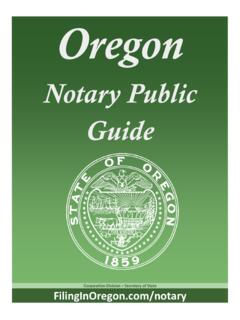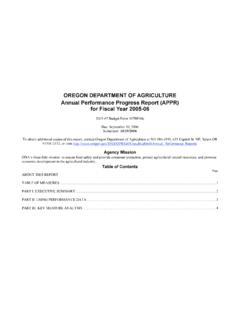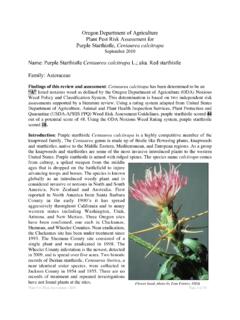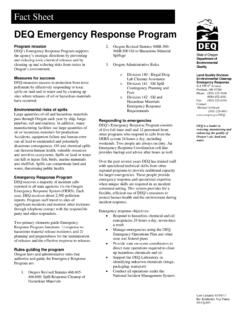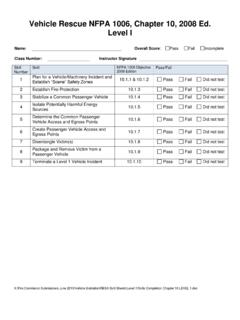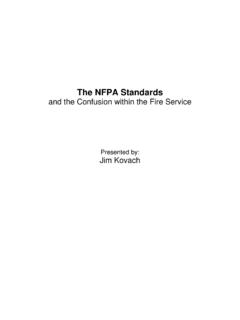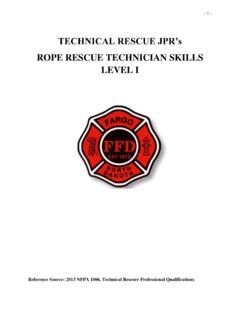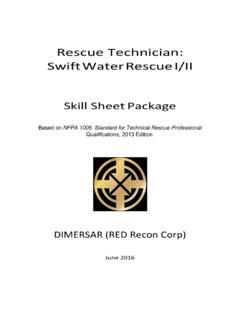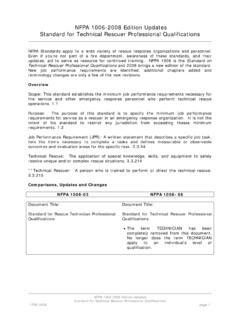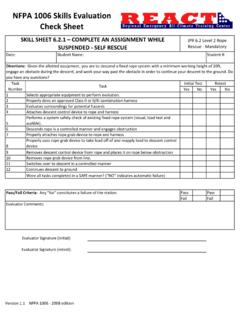Transcription of Vehicle and Machinery Rescue Technician - State Library of ...
1 State of Oregon Department of Public Safety Standards and Training Vehicle and Machinery Rescue Technician Task Book Vehicle and Machinery Rescue Technician Task Book Assigned To: Name DPSST Fire Service # Agency Name Date Initiated Portions of this evaluation instrument are reprinted with permission from nfpa 1006 - 2000 Edition, Standard for Rescue Technician Professional Qualifications , Copyright 2000. National Fire Protection Association, Quincy, MA 02269. This reprinted material is not the complete and official position of the nfpa on the referenced subject, which is represented only by the standard in its entirety. Department of Public Safety Standards and Training 4190 Aumsville Hwy. SE Salem, OR 97317 503-378-2100 Additional copies of this document may be downloaded from the DPSST web site: Vehicle and Machinery Rescue Technician Task Book Qualification Guide 2 Vehicle and Machinery Rescue Technician Signature Page A copy of this signature page and documentation of the applicants training must be included with the DPSST Rescue Technician application when applying for nfpa Vehicle and Machinery Rescue Technician certification.
2 Do not send the entire Task Book. Only a certified Rescue Technician in that specialty area may sign off the Task Book. Attest: The information contained in this Task Book is true and correct to the best of my knowledge. I understand that a false or misleading statement on this document is subject to penalty under ORS , et al, and ORS and may be cause to deny or revoke a fire service professional certification. Vehicle and Machinery Rescue Technician Task Book Assigned To: Signature Printed Name DPSST Fire Service # Agency Name Date Initiated Signature of Certified Technician Printed Name of Certified Technician Date Completed Rescue Technician Evaluators: Each Evaluator must document the following information: Evaluator: Level of Rescue Technician certification: _____Rope _____Surface Water _____Vehicle & Machinery _____Confined Space _____Structural Collapse _____Trench Sections of chapter signed off by Evaluator: _____2 _____3 _____6 Signature of Evaluator Printed name of Evaluator DPSST Fire # Date Evaluator: Level of Rescue Technician certification.
3 _____Rope _____Surface Water _____Vehicle & Machinery _____Confined Space _____Structural Collapse _____Trench Sections of chapter signed off by Evaluator: _____2 _____3 _____6 Signature of Evaluator Printed name of Evaluator DPSST Fire # Date Evaluator: Level of Rescue Technician certification: _____Rope _____Surface Water _____Vehicle & Machinery _____Confined Space _____Structural Collapse _____Trench Sections of chapter signed off by Evaluator: _____2 _____3 _____6 Signature of Evaluator Printed name of Evaluator DPSST Fire # Date Evaluator: Level of Rescue Technician certification: _____Rope _____Surface Water _____Vehicle & Machinery _____Confined Space _____Structural Collapse _____Trench Sections of chapter signed off by Evaluator: _____2 _____3 _____6 Signature of Evaluator Printed name of Evaluator DPSST Fire # Date Evaluator: Level of Rescue Technician certification: _____Rope _____Surface Water _____Vehicle & Machinery _____Confined Space _____Structural Collapse _____Trench Sections of chapter signed off by Evaluator: _____2 _____3 _____6 Signature of Evaluator Printed name of Evaluator DPSST Fire # Date Vehicle and Machinery Rescue Technician Task Book Qualification Guide 3 Task Book Qualification Record Books (Task Book) have been developed for various certification levels within the Oregon Department of Public Safety Standards and Training (DPSST) system.
4 Each Task Book lists the job performance requirements (JPRs) for the specific certification level in a format that allows a candidate to be trained and evaluated in the skills of that position. Successful performance of all tasks, as observed and recorded by a certified Rescue Technician in that discipline, will result in the candidate s eligibility for DPSST certification. To become certified at a specific level, the applicant must successfully complete all the job performance requirements. Before a job performance requirement may be taken, all requisite knowledge and skills must be satisfied. Only requisite knowledge and skills may be signed off in the classroom setting by the instructor. Only a certified Rescue Technician in that specialty Rescue area may sign off all relative Task Book evaluations at the candidates agency. When all prescribed requirements are completed, an application for certification may be submitted to DPSST.
5 All certificates are mailed to the Training Officer at the agency. Note to agencies: It is highly recommended that an agency considering a Rescue Technician program reviews nfpa 1670 and follows those standards. These JPRs are general guidelines. As such they are not intended to replace specific sequences of apparatus or equipment operation that may be outlined by manufacturer specifications. At all times, standard operating procedures of the agency in which the evaluation is being conducted will govern. The agencies should have available for evaluators a copy of manufacturer specifications and the agency s standard operational guidelines. The JPRs covered in this Task Book meet or exceed all nfpa published standards for this certification level at the time of this publication. Mention of nfpa and its standards do not, and are not intended as adoption of or reference to nfpa standards.
6 HOW TO EVALUATE PERFORMANCE Each JPR has a corresponding box to the right in which to confirm a candidate s success in a sequence. The evaluator shall indicate successful passing by the candidate of each JPR by initialing and dating. The candidate needs only perform the skill once to complete. These skills are to be tested after the candidate has completed the training program and by using the equipment of the agency. Testing in the training program does not constitute completion of the skill in a Task Book. Requisite knowledge and skills may be signed off in the training program. Transfer a victim to emergency medical services (EMS), given local medical protocols, so that all pertinent information is passed from rescuer to EMS provider, and the victim can be transported to a medical care facility. Vehicle and Machinery Rescue Technician Task Book Qualification Guide 4 Task Book Qualification Record For the Certification Level of Vehicle and Machinery Rescue Technician Prior to becoming certified in this position, the candidate shall successfully complete the following Job Performance Requirements (JPR).
7 The evaluator shall initial and date the appropriate box to indicate successful completion of each. For each JPR there are requisite knowledge and skill requirements. These requirements must be met before candidate may proceed. 2-1 Because technical Rescue is inherently dangerous and Rescue technicians are frequently required to perform rigorous activities in adverse conditions, regional and national safety standards shall be included in agency policies and procedures. Rescue technicians shall complete all activities in the safest possible manner and shall follow national, federal, State , provincial, and local safety standards as they apply to the Rescue Technician . 2-2 Before beginning training activities or engaging in Rescue incidents the following requirements shall be complied with: (1) Age requirements established by the authority having jurisdiction. (AHJ) (2) Medical requirements established by the AHJ.
8 (3) Minimum physical fitness as required by the AHJ. (4) Emergency medical care performance capabilities for entry-level personnel developed and validated by the AHJ. (5) Minimum educational requirements established by the AHJ. (6) Minimum requirements for hazardous material incident and contact control training for entry-level personnel, validated by the AHJ. 2-3 For certification, the Rescue Technician shall perform all of the job performance requirements in Chapter 3 and all job performance requirements listed in at least one of the specialty areas (Chapters 4-9). Vehicle and Machinery Rescue Technician Task Book Qualification Guide 5 3-2 Site Operations Identify the needed support resources, given a specific type of Rescue incident, so that a resource cache is managed, scene lighting is adequate for the tasks to be undertaken, environmental concerns are managed, personnel rehabilitation is facilitated, and the support operation facilitates Rescue operational objectives.
9 (a) Requisite Knowledge: Equipment organization and tracking methods, lighting resource type and availability, shelter and thermal control options, and rehab criteria. (b) Requisite Skills: The ability to track equipment inventory, identify lighting resources and structures for shelter and thermal protection, select rehab areas, and manage personnel rotations. Size up a Rescue incident, given background information and applicable reference materials, so that the type of Rescue is determined, the number of victims is identified, the last reported location of all victims is established, witnesses are identified and interviewed, resource needs are assessed, search parameters are identified, and information required to develop an incident action plan is obtained. (a) Requisite Knowledge: Types of reference materials and their uses, availability and capability of the resources, elements of an action plan and related information, relationship of sizeup to the incident management system, and information gathering techniques and how that information is used in the sizeup process.
10 (b) Requisite Skills: The ability to read technical Rescue reference materials, gather information, relay information, and use information gathering sources. Manage incident hazards, given scene control barriers personal protective equipment, requisite equipment, and available specialized resources, so that all hazards are identified, resource application fits the operational requirements, hazard isolation is considered, risks to rescuers and victims are minimized, and Rescue time constraints are taken into account. (a) Requisite Knowledge: Resource capabilities and limitations, types, and nature of incident hazards, equipment types and their use, isolation terminology, methods, equipment and implementation, operational requirement concerns, common types of rescuer and victim risk, risk-benefit analysis methods and practices, and types of technical references.

